ESP CHEVROLET CAMARO 1967 1.G Chassis Owner's Manual
[x] Cancel search | Manufacturer: CHEVROLET, Model Year: 1967, Model line: CAMARO, Model: CHEVROLET CAMARO 1967 1.GPages: 659, PDF Size: 114.24 MB
Page 426 of 659
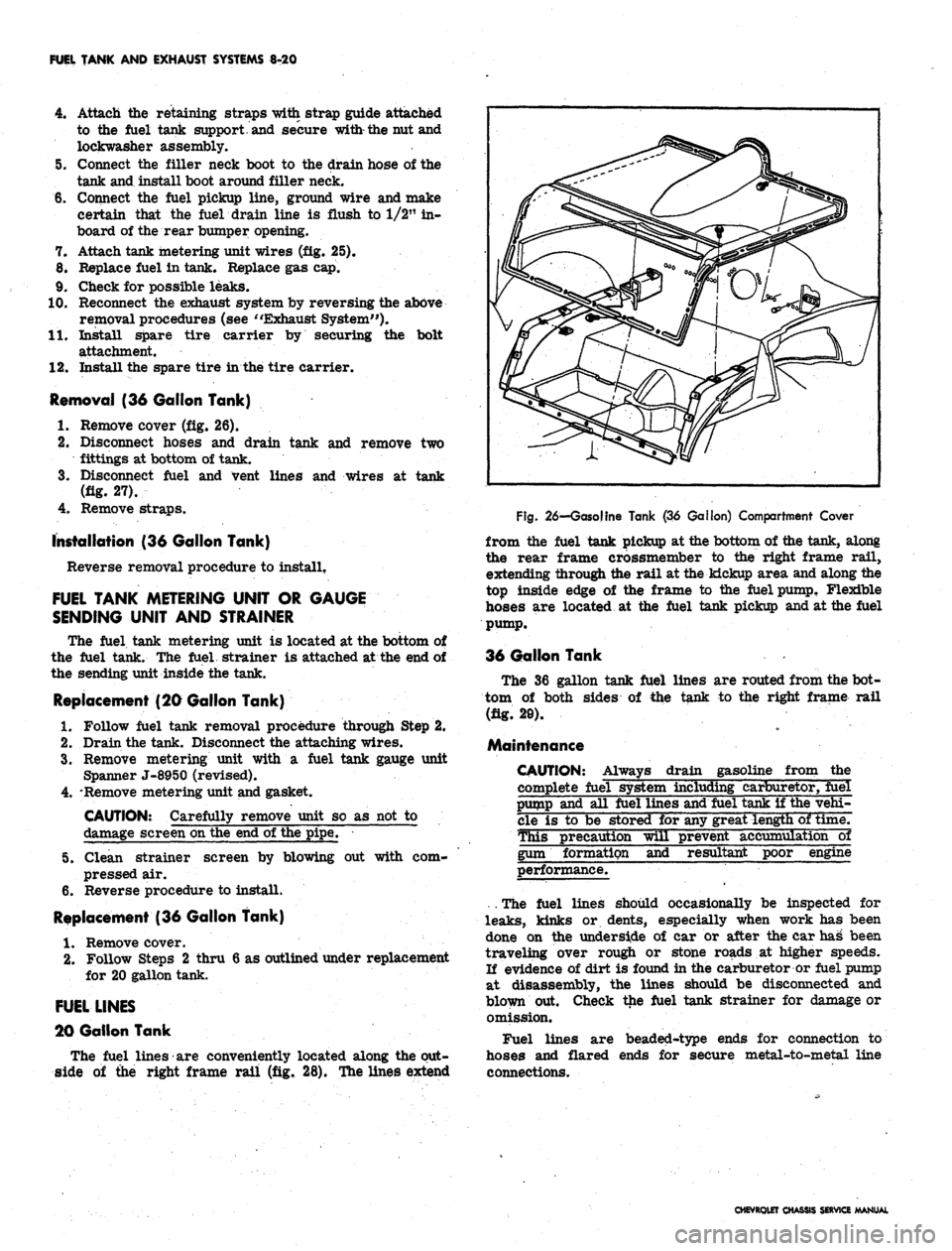
FUEL TANK AND EXHAUST SYSTEMS 8-20
4.
Attach the retaining straps with strap guide attached
to the fuel tank support, and secure with-the nut and
lockwasher assembly.
5. Connect the filler neck boot to the drain hose of the
tank and install boot around filler neck,
6. Connect the fuel pickup line, ground wire and make
certain that the fuel drain line is flush to 1/2" in-
board of the rear bumper opening.
7. Attach tank metering unit wires (fig. 25).
8. Replace fuel in tank. Replace gas cap.
9. Check for possible leaks.
10.
Reconnect the exhaust system by reversing the above
removal procedures (see "Exhaust System").
11.
Install spare tire carrier by securing the bolt
attachment.
12.
Install the spare tire in the tire carrier.
Removal (36 Gallon Tank)
1.
Remove cover (fig. 26).
2.
Disconnect hoses and drain tank and remove two
fittings at bottom of tank.
3.
Disconnect fuel and vent lines and wires at tank
(fig. 27).
4.
Remove straps.
installation (36 Gallon Tank)
Reverse removal procedure to install.
FUEL TANK METERING UNIT OR GAUGE
SENDING UNIT AND STRAINER
The fuel tank metering unit is located at the bottom of
the fuel tank. The fuel strainer is attached at the end of
the sending unit inside the tank.
Replacement (20 Gallon Tank)
1.
Follow fuel tank removal procedure through Step 2.
2.
Drain the tank. Disconnect the attaching wires.
3.
Remove metering unit with a fuel tank gauge unit
Spanner J-8950 (revised).
4.
'Remove metering unit and gasket.
CAUTION: Carefully remove unit so as not to
damage screen on the end of the pipe.
5. Clean strainer screen by blowing out with com-
pressed air.
6. Reverse procedure to install.
Replacement (36 Gallon Tank)
1.
Remove cover.
2.
Follow Steps 2 thru 6 as outlined under replacement
for 20 gallon tank.
FUEL LINES
20 Gallon Tank
The fuel lines are conveniently located along the out-
side of the right frame rail (fig. 28). The lines extend
Fig.
26—Gasoline Tank (36 Gallon) Compartment Cover
from the fuel tank pickup at the bottom of the tank, along
the rear frame crossmember to the right frame rail,
extending through the rail at the kickup area and along the
top inside edge of the frame to the fuel pump, Flexible
hoses are located at the fuel tank pickup and at the fuel
pump.
36 Gallon Tank
The 36 gallon tank fuel lines are routed from the bot-
tom of both sides of the tank to the right frame rail
(fig. 20).
Maintenance
CAUTION: Always drain gasoline from the
complete fuel system including carburetor, fuel
pump and all fuel lines and fuel tank if the vehi-
cle is to be stored for any great length of time.
This precaution will prevent accumulation~ol
gum formation and resultant poor engine
performance.
. The fuel lines should occasionally be inspected for
leaks,
kinks or dents, especially when work has been
done on the underside of car or after the car has been
traveling over rough or stone roads at higher speeds.
If evidence of dirt is found in the carburetor or fuel pump
at disassembly, the lines should be disconnected and
blown put. Check the fuel tank strainer for damage or
omission.
Fuel lines are beaded-type ends for connection to
hoses and flared ends for secure metal-to-metal line
connections.
CHEVROLET CHASSIS SERVICE MANUAL
Page 481 of 659
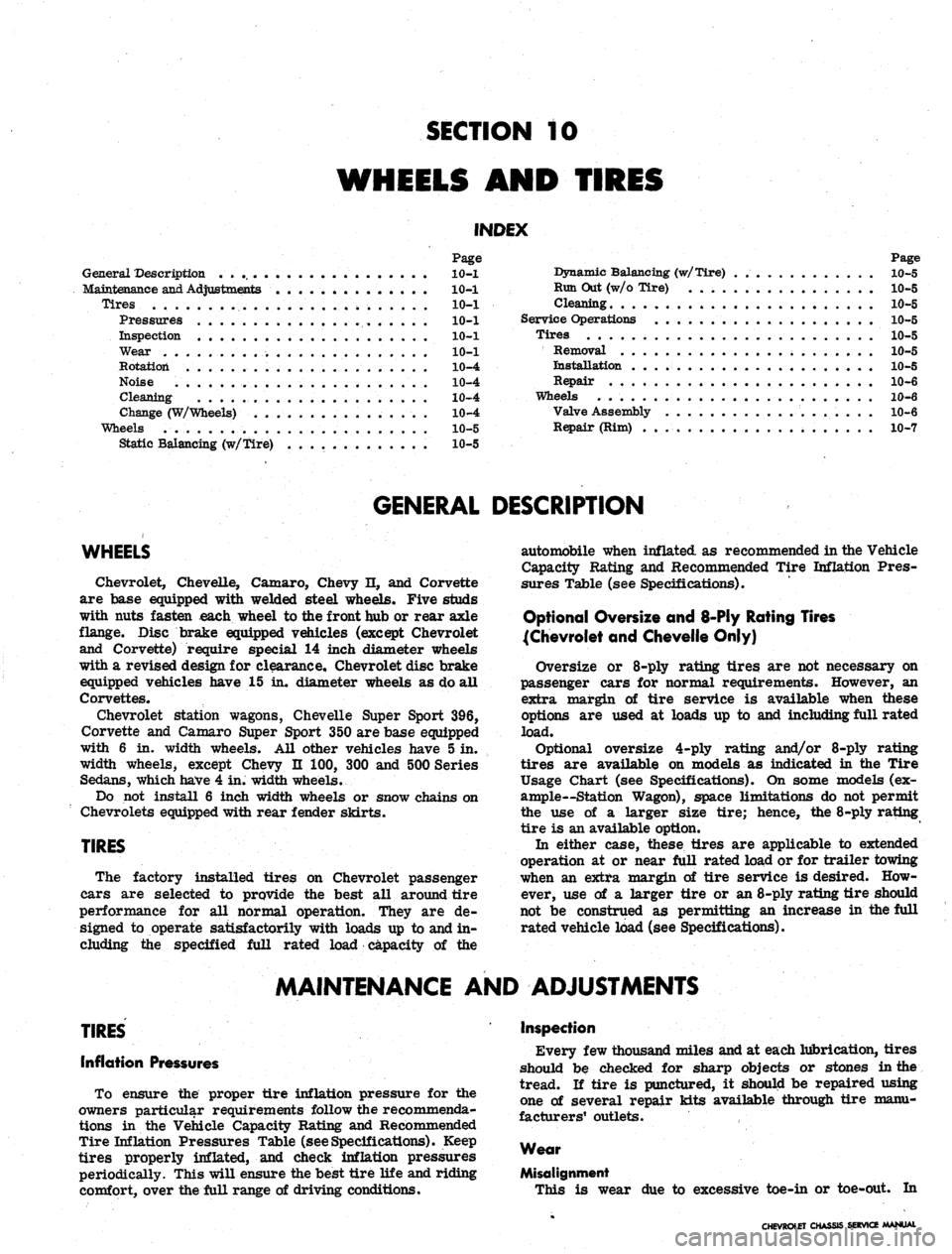
SECTION 10
WHEELS AND TIRES
INDEX
Page
General Description
10-1
Maintenance
and
Adjustments
.............. 10—1
Tires
10-1
Pressures . 10-1
Inspection 10-1
Wear 10-1
Rotation 10-4
Noise 10-4
Cleaning 10-4
Change (W/Wheels) 10-4
Wheels 10-5
Static Balancing (w/Tire) 10-5
Page
Dynamic Balancing (w/Tire) . 10-5
Run Out (w/o Tire) 10-5
Cleaning 10-5
Service Operations 10-5
Tires 10-5
Removal 10-5
Installation 10-5
Repair 10^6
Wheels . 10-6
Valve Assembly 10-6
Repair (Rim) 10-7
GENERAL DESCRIPTION
WHEELS
Chevrolet, Chevelle, Camaro, Chevy n, and Corvette
are base equipped with welded steel wheels. Five studs
with nuts fasten each wheel to the front hub or rear axle
flange. Disc brake equipped vehicles (except Chevrolet
and Corvette) require special 14 inch diameter wheels
with a revised design for clearance, Chevrolet disc brake
equipped vehicles have 15 in. diameter wheels as do all
Corvettes.
Chevrolet station wagons, Chevelle Super Sport 396,
Corvette and Camaro Super Sport 350 are base equipped
with 6 in. width wheels. All other vehicles have 5 in.
width wheels, except Chevy n 100, 300 and 500 Series
Sedans, which have 4 in. width wheels.
Do not install 6 inch width wheels or snow chains on
Chevrolets equipped with rear fender skirts.
TIRES
The factory installed tires on Chevrolet passenger
cars are selected to provide the best all around tire
performance for all normal operation. They are de-
signed to operate satisfactorily with loads up to and in-
cluding the specified full rated load capacity of the
automobile when inflated as recommended in the Vehicle
Capacity Rating and Recommended Tire Inflation Pres-
sures Table (see Specifications).
Optional Oversize and 8-Ply Rating Tires
{Chevrolet and Chevelle Only)
Oversize or 8-ply rating tires are not necessary on
passenger cars for normal requirements. However, an
extra margin of tire service is available when these
options are used at loads up to and including full rated
load.
Optional oversize 4-ply rating and/or 8-ply rating
tires are available on models as indicated in the Tire
Usage Chart (see Specifications). On some models (ex-
ample—Station Wagon), space limitations do not permit
the use of a larger size tire; hence, the 8-ply rating
tire is an available option.
In either case, these tires are applicable to extended
operation at or near full rated load or for trailer towing
when an extra margin of tire service is desired. How-
ever, use of a larger tire or an 8-ply rating tire should
not be construed as permitting an increase in the full
rated vehicle load (see Specifications).
MAINTENANCE AND ADJUSTMENTS
TIRES
Inflation Pressures
To ensure the proper tire inflation pressure for the
owners particular requirements follow the recommenda-
tions in the Vehicle Capacity Rating and Recommended
Tire Inflation Pressures Table (seeSpecifications). Keep
tires properly inflated, and check inflation pressures
periodically. This will ensure the best tire life and riding
comfort, over the full range of driving conditions.
Inspection
Every few thousand miles and at each lubrication, tires
should be checked for sharp objects or stones in the
tread. H tire is punctured, it should be repaired using
one of several repair kits available through tire manu-
facturers1 outlets.
Wear
Misalignment
This is wear due to excessive toe-in or toe-out. In
CHEVROLET CHASSIS SERVICE MANUAL
Page 485 of 659
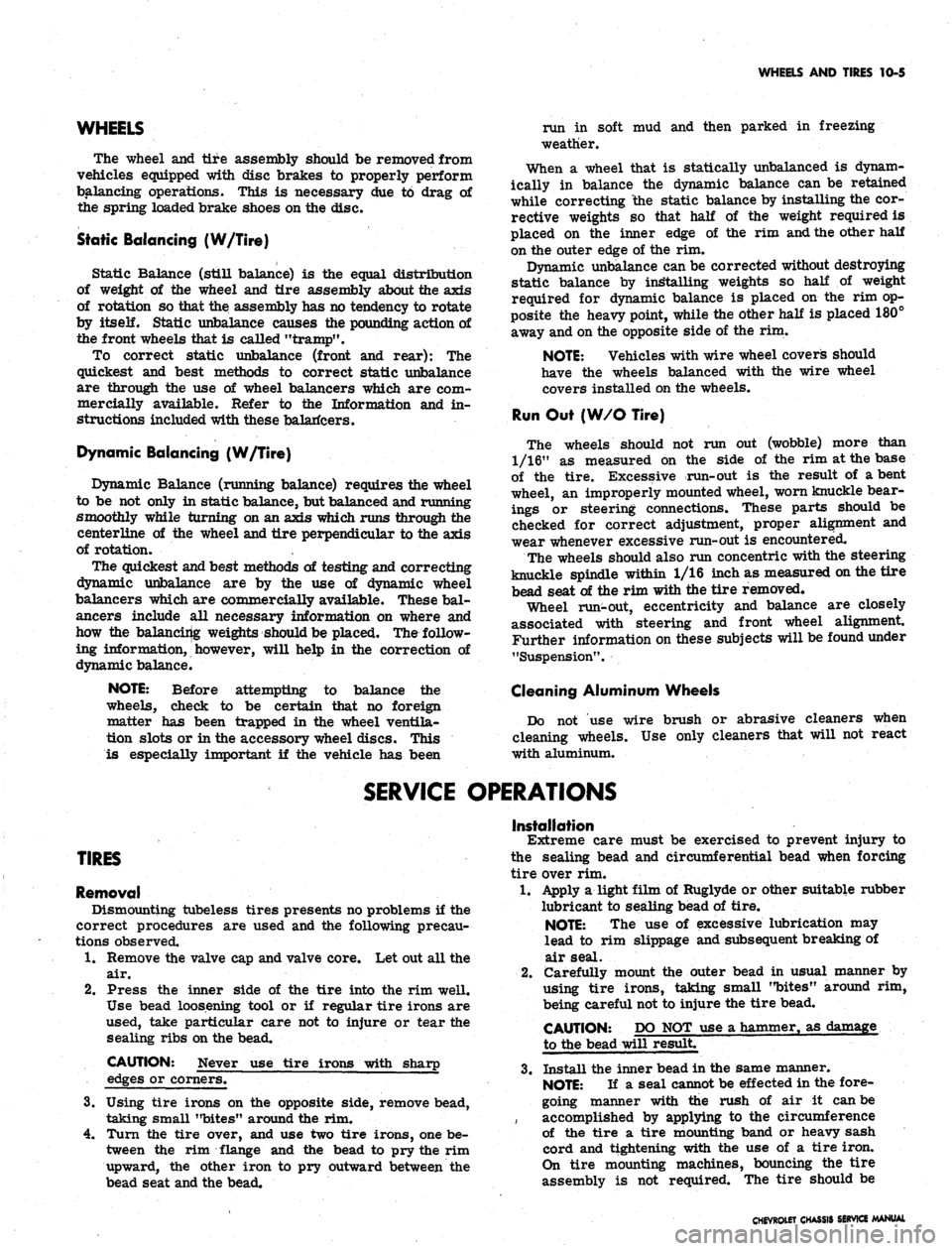
WHEELS AND TIRES 10-5
WHEELS
The wheel and tire assembly should be removed from
vehicles equipped with disc brakes to properly perform
balancing operations. This is necessary due to drag of
the spring loaded brake shoes on the disc.
Static Balancing (W/Tire)
Static Balance (still balance) is the equal distribution
of weight of the wheel and tire assembly about the axis
of rotation so that the assembly has no tendency to rotate
by
itself.
Static unbalance causes the pounding action of
the front wheels that is called "tramp".
To correct static unbalance (front and rear): The
quickest and best methods to correct static unbalance
are through the use of wheel balancers which are com-
mercially available. Refer to the Information and in-
structions included with these balaricers.
Dynamic Balancing (W/Tire)
Dynamic Balance (running balance) requires the wheel
to be not only in static balance, but balanced and running
smoothly while turning on an axis which runs through the
centerline of the wheel and tire perpendicular to the axis
of rotation.
The quickest and best methods of testing and correcting
dynamic unbalance are by the use of dynamic wheel
balancers which are commercially available. These bal-
ancers include all necessary information on where and
how the balancing weights should be placed. The follow-
ing information, however, will help in the correction of
dynamic balance.
NOTE:
Before attempting to balance the
wheels, check to be certain that no foreign
matter has been trapped in the wheel ventila-
tion slots or in the accessory wheel discs. This
is especially important if the vehicle has been
run in soft mud and then parked in freezing
weather.
When a wheel that is statically unbalanced is dynam-
ically in balance the dynamic balance can be retained
while correcting "the static balance by installing the cor-
rective weights so that half of the weight required is
placed on the inner edge of the rim and the other half
on the outer edge of the rim.
Dynamic unbalance can be corrected without destroying
static balance by installing weights so half of weight
required for dynamic balance is placed on the rim op-
posite the heavy point, while the other half is placed 180°
away and on the opposite side of the rim.
NOTE:
Vehicles with wire wheel covers should
have the wheels balanced with the wire wheel
covers installed on the wheels.
Run Out (W/OTire)
The wheels should not run out (wobble) more than
1/16" as measured on the side of the rim at the base
of the tire. Excessive run-out is the result of a bent
wheel, an improperly mounted wheel, worn knuckle bear-
ings or steering connections. These parts should be
checked for correct adjustment, proper alignment and
wear whenever excessive run-out is encountered.
The wheels should also run concentric with the steering
knuckle spindle within 1/16 inch as measured on the tire
bead seat of the rim with the tire removed.
Wheel run-out, eccentricity and balance are closely
associated with steering and front wheel alignment.
Further information on these subjects will be found under
"Suspension".
Cleaning Aluminum Wheels
Do not use wire brush or abrasive cleaners when
cleaning wheels. Use only cleaners that will not react
with aluminum.
SERVICE OPERATIONS
TIRES
Removal
Dismounting tubeless tires presents no problems if the
correct procedures are used and the following precau-
tions observed.
1.
Remove the valve cap and valve core. Let out all the
air.
2.
Press the inner side of the tire into the rim well.
Use bead loosening tool or if regular tire irons are
used, take particular care not to injure or tear the
sealing ribs on the bead.
CAUTION: Never use tire irons with sharp
edges or corners.
3.
Using tire irons on the opposite side, remove bead,
taking small "bites" around the rim.
4.
Turn the tire over, and use two tire irons, one be-
tween the rim flange and the bead to pry the rim
upward, the other iron to pry outward between the
bead seat and the bead.
Installation
Extreme care must be exercised to prevent injury to
the sealing bead and circumferential bead when forcing
tire over rim.
1.
Apply a light film of Ruglyde or other suitable rubber
lubricant to sealing bead of tire.
NOTE:
The use of excessive lubrication may
lead to rim slippage and subsequent breaking of
air seal.
2.
Carefully mount the outer bead in usual manner by
using tire irons, taking small "bites" around rim,
being careful not to injure the tire bead.
CAUTION: DO NOT use a hammer, as damage
to the bead will result.
3.
Install the inner bead in the same manner.
NOTE:
If a seal cannot be effected in the fore-
going manner with the rush of air it can be
, accomplished by applying to the circumference
of the tire a tire mounting band or heavy sash
cord and tightening with the use of a tire iron.
On tire mounting machines, bouncing the tire
assembly is not required. The tire should be
CHEVROLET CHASSIS SERVICE MANUAL
Page 486 of 659
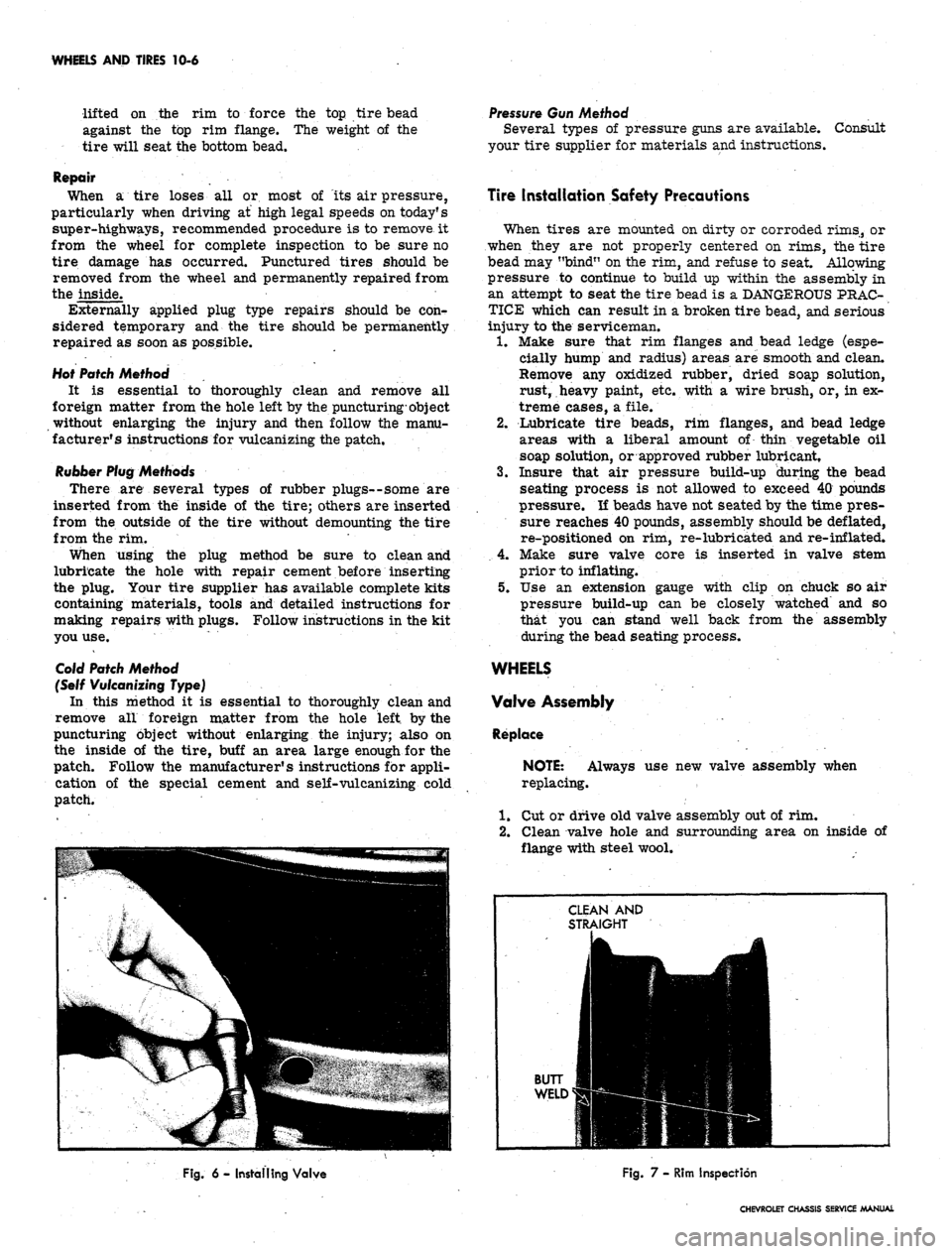
WHEELS AND TIRES
10-6
lifted on the rim to force the top tire bead
against the top rim flange. The weight of the
tire will seat the bottom bead.
Repair
When a tire loses all or most of its air pressure,
particularly when driving at high legal speeds on today1 s
super-highways, recommended procedure is to remove it
from the wheel for complete inspection to be sure no
tire damage has occurred. Punctured tires should be
removed from the wheel and permanently repaired from
the inside.
Externally applied plug type repairs should be con-?
sidered temporary and the tire should be permanently
repaired as soon as possible.
Hot Patch Method
It is essential to thoroughly clean and remove all
foreign matter from the hole left by the puncturing-object
without enlarging the injury and then follow the manu-
facturer's instructions for vulcanizing the patch.
Rubber Plug Methods
There are several types of rubber plugs--some are
inserted from the inside of the tire; others are inserted
from the outside of the tire without demounting the tire
from the rim.
When using the plug method be sure to clean and
lubricate the hole with repair cement before inserting
the plug. Your tire supplier has available complete kits
containing materials, tools and detailed instructions for
making repairs with plugs. Follow instructions in the kit
you use.
Cold Patch Method
(Self Vulcanizing Type)
In this method it is essential to thoroughly clean and
remove all foreign matter from the hole left by the
puncturing object without enlarging the injury; also on
the inside of the tire, buff an area large enough for the
patch. Follow the manufacturer1 s instructions for appli-
cation of the special cement and self-vulcanizing cold
patch.
Pressure Gun Method
Several types of pressure guns are available. Consult
your tire supplier for materials and instructions.
Tire Installation Safety Precautions
When tires are mounted on dirty or corroded rims, or
when they are not properly centered on rims, the tire
bead may "bind" on the rim, and refuse to seat. Allowing
pressure to continue to build up within the assembly in
an attempt to seat the tire bead is a DANGEROUS PRAC-
TICE which can result in a broken tire bead, and serious
injury to the serviceman.
1.
Make sure that rim flanges and bead ledge (espe-
cially hump and radius) areas are smooth and clean.
Remove any oxidized rubber, dried soap solution,
rust, heavy paint, etc. with a wire brush, or, in ex-
treme cases, a file.
2.
Lubricate tire beads, rim flanges, and bead ledge
areas with a liberal amount of thin vegetable oil
soap solution, or approved rubber lubricant,
3.
Insure that air pressure build-up during the bead
seating process is not allowed to exceed 40 pounds
pressure. If beads have not seated by the time pres-
sure reaches 40 pounds, assembly should be deflated,
re-positioned on rim, re-lubricated and re-inflated.
4.
Make sure valve core is inserted in valve stem
prior to inflating.
5.
Use an extension gauge with clip on chuck so air
pressure build-up can be closely watched and so
that you can stand well back from the assembly
during the bead seating process.
WHEELS
Valve Assembly
Replace
NOTE: Always use new valve assembly when
replacing.
1.
Cut or drive old valve assembly out of rim.
2.
Clean valve hole and surrounding area on inside of
flange with steel wool.
Fig. 6 - Installing Valve
Fig. 7 - Rim Inspection
CHEVROLET CHASSIS SERVICE MANUAL
Page 564 of 659
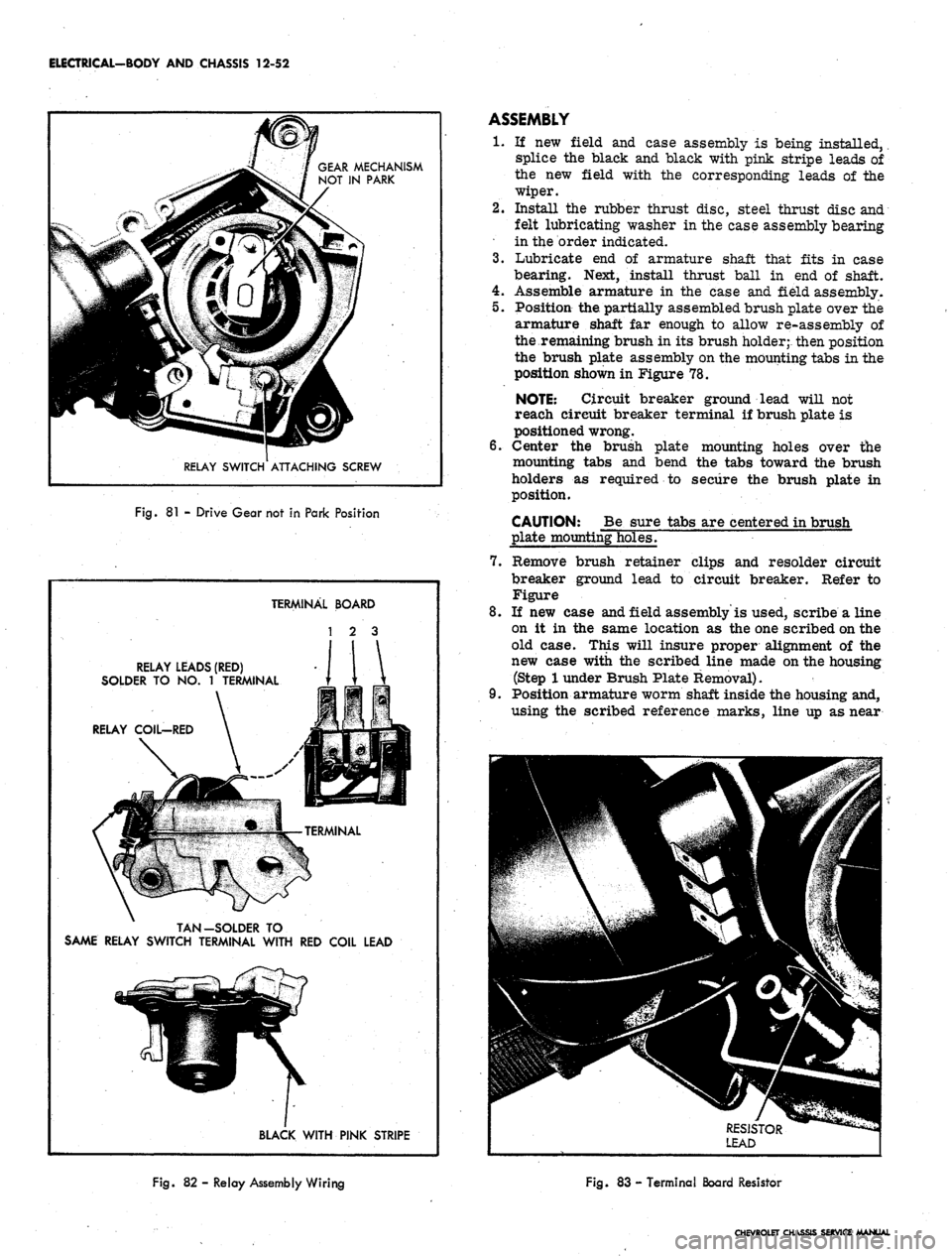
ELECTRICAL-BODY AND CHASSIS 12-52
GEAR MECHANISM
NOT IN PARK
RELAY SWITCH ATTACHING SCREW
Fig.
81 -
Drive Gear not
in
Park Position
TERMINAL BOARD
1 2 3
RELAY LEADS (RED)
SOLDER TO NO. 1 TERMINAL
RELAY
COIL-RED
TAN-SOLDER TO
SAME RELAY SWITCH TERMINAL WITH RED COIL LEAD
BLACK WITH PINK STRIPE
ASSEMBLY
1.
If new field and case assembly is being installed,
splice the black and black with pink stripe leads of
the new field with the corresponding leads of the
wiper.
2.
Install the rubber thrust disc, steel thrust disc and
felt lubricating washer in the case assembly bearing
in the order indicated.
3.
Lubricate end of armature shaft that fits in case
bearing. Next, install thrust ball in end of shaft.
4.
Assemble armature in the case and field assembly.
5.
Position the partially assembled brush plate over the
armature shaft far enough to allow re-assembly of
the remaining brush in its brush holder;- then position
the brush plate assembly on the mounting tabs in the
position shown in Figure 78.
NOTE: Circuit breaker ground lead will not
reach circuit breaker terminal if brush plate is
positioned wrong.
6. Center the brush plate mounting holes over the
mounting tabs and bend the tabs toward the brush
holders as required to secure the brush plate in
position.
CAUTION: Be sure tabs are centered in brush
plate mounting holes.
7.
Remove brush retainer clips and resolder circuit
breaker ground lead to circuit breaker. Refer to
Figure
8. If new case and field assembly'is used, scribe a line
on it in the same location as the one scribed on the
old case. This will insure proper alignment of the
new case with the scribed line made on the housing
(Step
1
under Brush Plate Removal).
9. Position armature worm shaft inside the housing and,
using the scribed reference marks, line up as near
Fig.
82 - Relay Assembly Wiring
Fig.
83 -
Terminal Board Resistor
CHEVROLET CHASSIS SERVICE MANUAL
Page 567 of 659

ELECTRICAL-BODY
AND
CHASSIS
12-55
COVER RELAY COIL
ASSEMBLY
PAWL SPRING
a=-
VALVE ASSEMBLY
RATCHET DOG AND _/_ f1
LATCHOUT SPRING ^—-»*
PAWL
RATCHET WHEEL
J
Fig.
SO
-
Exploded View
of
Pump
Relay Switch—Latch and Terminal Board Assembly
1.
Resolder leads
to
wiper terminal board as required
(fig. 82).
2.
Slide terminal board into wiper housing being careful
to position the terminal board resistor lead as shown
in Figure 83.
3.
Resolder leads
to
relay switch assembly
as
required
(fig. 82).
4.
Position relay-switch assembly
in
housing.
CAUTION:
Be
very careful
to
route leads
in
such
a
manner
as to
avoid having them pinched
between relay and wiper housing.
5. Install relay-switch mounting screw.
6. Assemble gear box cover and washer pump assembly
to wiper being careful that the ground strap
is
prop-
erly connected. Refer
to
Figure 75 for assembly
of
washer pump
to
gear housing.
B-Drive Gear Disassembly (Fig.
84)
1.
Remove washer pump assembly.
2.
Remove crank
arm
retaining nut, crank arm, rubber
seal
cap,
retaining ring, shim washers, shield
and
spacer washer in the order indicated.
3.
Slide gear assembly out
of
housing (fig. 85).
4.
Slide drive plate and shaft out
of
gear and remove the
drive pawl, lock pawl
and
coil spring
as
required.
Drive Gear—Assembly
1.
Position drive pawl
on
drive plate
as
shown
in
Fig.
ure 86.
2.
Assemble lock pawl over drive pawl
as
shown
in
Figure
86.
3.
Slide gear
and
tube over
the
drive shaft (fig. 87).
(Move drive and lock pawls
as
required to allow their
respective pins
to fit in the
gear guide channel,
fig.
88).
4.
Holding
the
gear, manually rotate
the
drive plate
until
the
drive
and
lock pawl guide pins snap into
their respective pockets in the gear (fig. 88).
5. Reinstall coil spring between lock
and
drive pawls
(fig. 88).
IMPORTANT: Be very careful
to
maintain lock
and drive pawl guide pins
in
their respective
pockets during Step
6.
6. Assemble inner spacer washer over gear shaft
and
assemble gear mechanism
in
housing
so
that
it is
positioned with respect to the housing in the approxi-
mate location shown
in
Figure 85.
7. Reassemble
the
outer spacer washer, shield, shim
washers
as
required
to
obtain .005"
max.
end play,
snap ring and rubber seal cap in the order indicated.
Refer to Figure 84.
8. Operate wiper
to
"park"
or
"off" position and install
crank arm.
9. Reassemble washer pump
to
wiper (fig. 75).
WASHER PUMP UNIT
The washer pump and/or valve assembly
may be re-
moved from the wiper assembly
as a
unit; therefore,
it is
not necessary
to
remove
the
wiper assembly irom
the
vehicle
if
only
the
washer pump and/or valve assembly
required service.
When
the
pump
is
removed from
the
wiper assembly,
all working parts
are
readily accessible and may easily
be serviced
as
necessary
(fig. 89).
An exploded view
of
the washer pump
is
shown in Figure 90.
Removal and Installation
1.
Raise vehicle hood.
2.
Disconnect washer hoses
and
electrical connections
from assembly.
3.
Remove
3
screws securing washer pump
and
cover
to wiper assembly. Remove pump from wiper gear
box.
4.
Position pump
and
cover assembly
to
the wiper and
install retaining screws.
5. Connect washer hoses
to
valve assembly and wiring
leads
to
pump and wiper terminals.
6. Check operation
of
unit.
CHEVROLET CHASSIS SERVICE MANUAL
Page 611 of 659
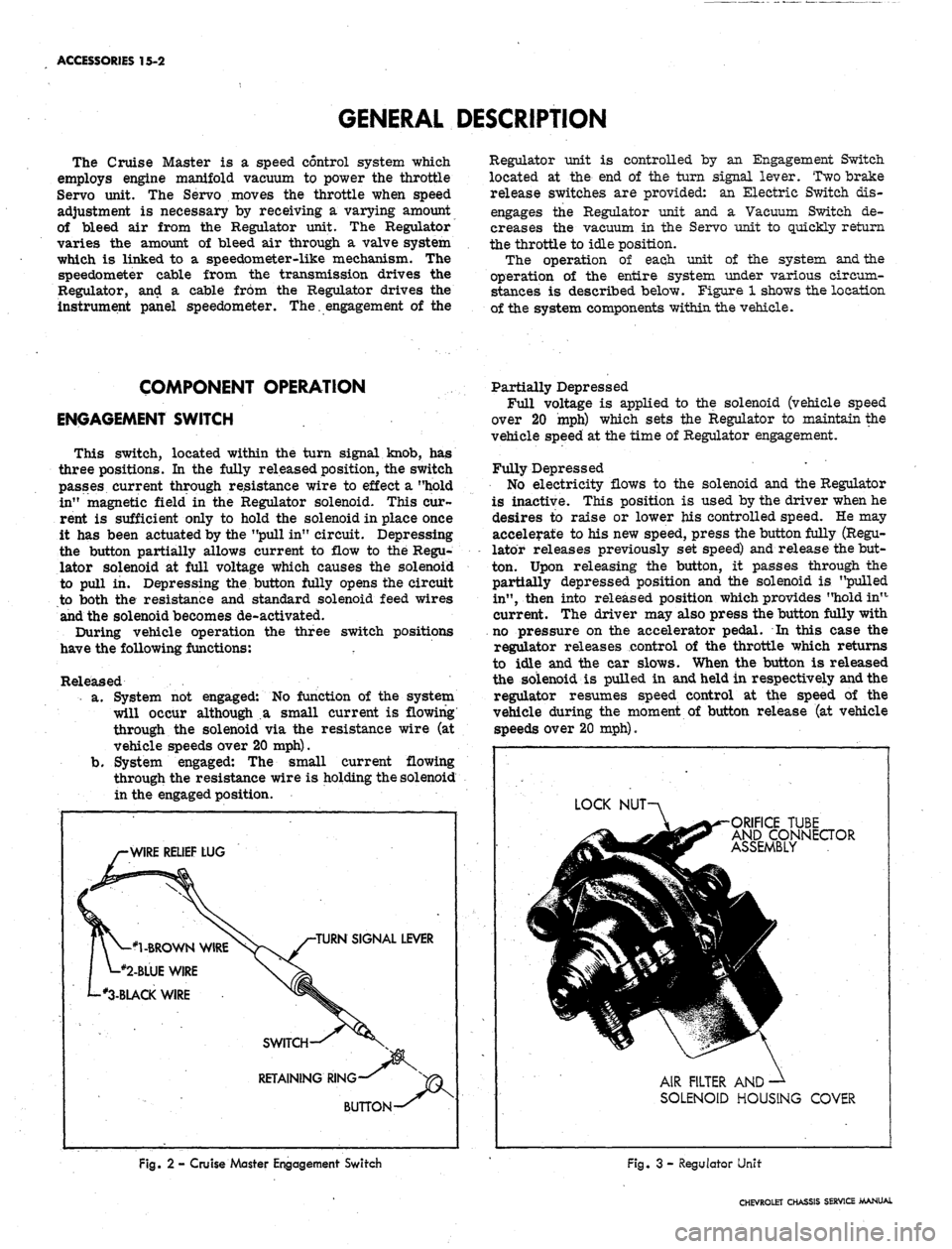
ACCESSORIES 15-2
GENERAL DESCRIPTION
The Cruise Master is a speed control system which
employs engine manifold vacuum to power the throttle
Servo unit. The Servo moves the throttle when speed
adjustment is necessary by receiving a varying amount
of bleed air from the Regulator unit. The Regulator
varies the amount of bleed air through a valve system
which is linked to a speedometer-like mechanism. The
speedometer cable from the transmission drives the
Regulator, and a cable from the Regulator drives the
instrument panel speedometer. The. engagement of the
Regulator unit is controlled by an Engagement Switch
located at the end of the turn signal lever. Two brake
release switches are provided: an Electric Switch dis-
engages the Regulator unit and a Vacuum Switch de-
creases the vacuum in the Servo unit to quickly return
the throttle to idle position.
The operation of each unit of the system and the
operation of the entire system under various circum-
stances is described below. Figure 1 shows the location
of the system components within the vehicle-
COMPONENT OPERATION
ENGAGEMENT SWITCH
This switch, located within the turn signal knob, has
three positions. In the fully released position, the switch
passes current through resistance wire to effect a "hold
in" magnetic field in the Regulator solenoid. This cur-
rent is sufficient only to hold the solenoid in place once
it has been actuated by the "pull in" circuit. Depressing
the button partially allows current to flow to the Regu-
lator solenoid at full voltage which causes the solenoid
to pull in. Depressing the button fully opens the circuit
to both the resistance and standard solenoid feed wires
and the solenoid becomes de-activated.
During vehicle operation the three switch positions
have the following functions:
Released
a. System not engaged: No function of the system
will occur although a small current is flowing
through the solenoid via the resistance wire (at
vehicle speeds over 20 mph).
b.
System engaged: The small current flowing
through the resistance wire is holding the solenoid
in the engaged position.
^r-WIRE RELIEF LUG
1 ^-#2-BLUE WIRE
L'3.BLACK WIRE
X /-TURN SIGNAL LEVER
SWITCH—^
^SN
RETAINING RING-^ %^
BUTTON -^
Fig.
2 - Cruise Master Engagement Switch
Partially Depressed
Full voltage is applied to the solenoid (vehicle speed
over 20 mph) which sets the Regulator to maintain the
vehicle speed at the time of Regulator engagement.
Fully Depressed
No electricity flows to the solenoid and the Regulator
is inactive. This position is used by the driver when he
desires to raise or lower his controlled speed. He may
accelerate to his new speed, press the button fully (Regu-
lator releases previously set speed) and release the but-
ton. Upon releasing the button, it passes through the
partially depressed position and the solenoid is "pulled
in", then into released position which provides "hold in"-
current. The driver may also press the button fully with
no pressure on the accelerator pedal. In this case the
regulator releases control of the throttle which returns
to idle and the car slows. When the button is released
the solenoid is pulled in and held in respectively and the
regulator resumes speed control at the speed of the
vehicle during the moment of button release (at vehicle
speeds over 20 mph).
LOCK
NUT
ORIFICE
TUBE
AND
CONNECTOR
ASSEMBLY
AIR FILTER AND
SOLENOID HOUSING COVER
Fig. 3 - Regulator Unit
CHEVROLET CHASSIS SERVICE MANUAL
Page 616 of 659
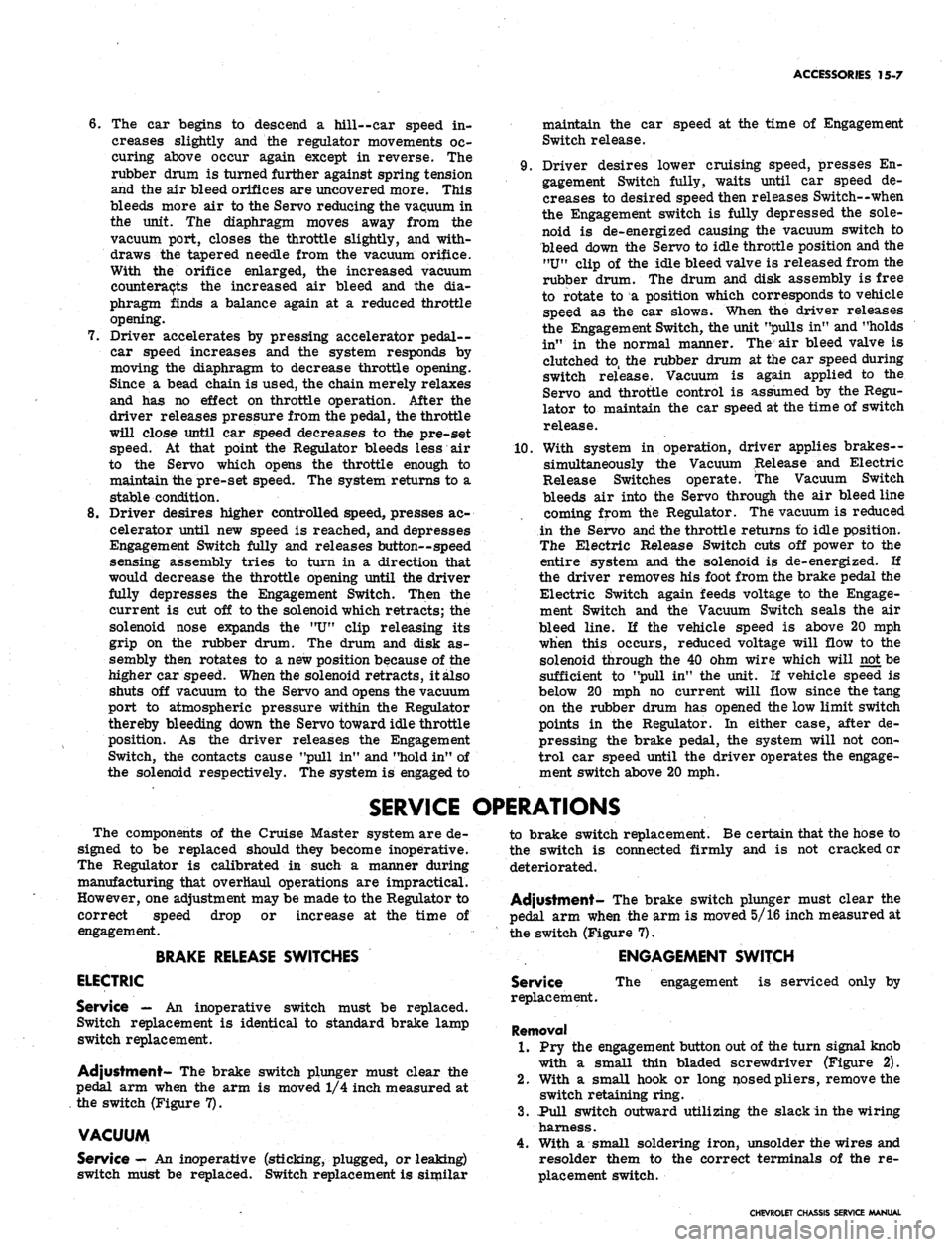
ACCESSORIES 15-7
6. The car begins to descend a hill--car speed in-
creases slightly and the regulator movements oc-
curing above occur again except in reverse. The
rubber drum is turned further against spring tension
and the air bleed orifices are uncovered more. This
bleeds more air to the Servo reducing the vacuum in
the unit. The diaphragm moves away from the
vacuum port, closes the throttle slightly, and with-
draws the tapered needle from the vacuum orifice.
With the orifice enlarged, the increased vacuum
counteracts the increased air bleed and the dia-
phragm finds a balance again at a reduced throttle
opening.
7.
Driver accelerates by pressing accelerator pedal-
car speed increases and the system responds by
moving the diaphragm to decrease throttle opening.
Since a bead chain is used, the chain merely relaxes
and has no effect on throttle operation. After the
driver releases pressure from the pedal, the throttle
will close until car speed decreases to the pre-set
speed. At that point the Regulator bleeds less air
to the Servo which opens the throttle enough to
maintain the pre-set speed. The system returns to a
stable condition.
8. Driver desires higher controlled speed, presses ac-
celerator until new speed is reached, and depresses
Engagement Switch fully and releases button--speed
sensing assembly tries to turn in a direction that
would decrease the throttle opening until the driver
fully depresses the Engagement Switch. Then the
current is cut off to the solenoid which retracts; the
solenoid nose expands the "U" clip releasing its
grip on the rubber drum. The drum and disk as-
sembly then rotates to a new position because of the
higher car speed. When the solenoid retracts, it also
shuts off vacuum to the Servo and opens the vacuum
port to atmospheric pressure within the Regulator
thereby bleeding down the Servo toward idle throttle
position. As the driver releases the Engagement
Switch, the contacts cause "pull in" and "hold in" of
the solenoid respectively. The system is engaged to
maintain the car speed at the time of Engagement
Switch release.
9. Driver desires lower cruising speed, presses En-
gagement Switch fully, waits until car speed de-
creases to desired speed then releases Switch--when
the Engagement switch is fully depressed the sole-
noid is de-energized causing the vacuum switch to
bleed down the Servo to idle throttle position and the
"U"
clip of the idle bleed valve is released from the
rubber drum. The drum and disk assembly is free
to rotate to a position which corresponds to vehicle
speed as the car slows. When the driver releases
the Engagement Switch, the unit "pulls in" and "holds
in" in the normal manner. The air bleed valve is
clutched to, the rubber drum at the car speed during
switch release. Vacuum is again applied to the
Servo and throttle control is assumed by the Regu-
lator to maintain the car speed at the time of switch
release.
10.
With system in operation, driver applies brakes--
simultaneously the Vacuum Release and Electric
Release Switches operate. The Vacuum Switch
bleeds air into the Servo through the air bleed line
coming from the Regulator. The vacuum is reduced
in the Servo and the throttle returns to idle position.
The Electric Release Switch cuts off power to the
entire system and the solenoid is de-energized. If
the driver removes his foot from the brake pedal the
Electric Switch again feeds voltage to the Engage-
ment Switch and the Vacuum Switch seals the air
bleed line. If the vehicle speed is above 20 mph
when this occurs, reduced voltage will flow to the
solenoid through the 40 ohm wire which will not be
sufficient to "pull in" the unit. If vehicle speed is
below 20 mph no current will flow since the tang
on the rubber drum has opened the low limit switch
points in the Regulator. In either case, after de-
pressing the brake pedal, the system will not con-
trol car speed until the driver operates the engage-
ment switch above 20 mph.
SERVICE OPERATIONS
The components of the Cruise Master system are de-
signed to be replaced should they become inoperative.
The Regulator is calibrated in such a manner during
manufacturing that overhaul operations are impractical.
However, one adjustment may be made to the Regulator to
correct speed drop or increase at the time of
engagement.
BRAKE RELEASE SWITCHES
ELECTRIC
Service — An inoperative switch must be replaced.
Switch replacement is identical to standard brake lamp
switch replacement.
Adjustment- The brake switch plunger must clear the
pedal arm when the arm is moved 1/4 inch measured at
the switch (Figure 7).
VACUUM
Service
—
An inoperative (sticking, plugged, or leaking)
switch must be replaced. Switch replacement is similar
to brake switch replacement. Be certain that the hose to
the switch is connected firmly and is not cracked or
deteriorated.
Adjustment- The brake switch plunger must clear the
pedal arm when the arm is moved 5/16 inch measured at
the switch (Figure 7).
ENGAGEMENT SWITCH
Service
replacement.
The engagement is serviced only by
Removal
1.
Pry the engagement button out of the turn signal knob
with a small thin bladed screwdriver (Figure 2).
2.
With a small hook or long nosed pliers, remove the
switch retaining ring.
3.
.Pull switch outward utilizing the slack in the wiring
harness.
4.
With a small soldering iron, unsolder the wires and
resolder them to the correct terminals of the re-
placement switch.
CHEVROLET CHASSIS SERVICE MANUAL